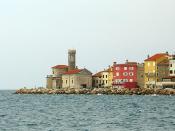Introduction
Slovenia, one of six Former Yugoslavia republics, is situated in the Balkan Peninsula and borders with Austria, Hungary, Italy and Croatia. Slovenia became independent in 1991; it was the first republic to ask for independence when the war started. It became a member of the United Nations in 1992 and is waiting to join the European Union in 2004, as the country voted in favor of EU in the recent referendum. Slovenia occupies the area of 20,273 sq km with the capital its largest city, Ljubljana with 330,000 inhabitants. The population counting at 1,930,132 has a density of 95 persons per square kilometer (Britannica). 52 percent of all population lives in urban areas and the rest in rural areas throughout the country, especially in the mountain villages.
The official language is Slovenian. Slovenia was the most developed Republic of Former Yugoslavia because of its closeness with countries of Western Europe.
It is highly influenced by the German and Austrian cultures and has many similarities with them. The religion is Catholic but there are some minorities living there, i.e. Serbs (2 percent), Croats (3 percent) and various other groups. Another notable fact is that 20,000 refugees from Bosnia and Herzegovina live there.
The Slovenian government requires that all children attend school between the ages of 7 and 15. Almost all Slovenes above ten can read and write, and 36 percent of students finish High schools or higher levels of education. There are 30 institutions of higher education in Slovenia; among them is the University of Ljubljana, which was founded in 1595.
In 1991 the Slovenian government adopted a constitution that guarantees a number of civil rights, has adopted many elements of democratic government. In December all Slovenes age 18 and older musts vote (Slovenes age 16 and older may...
